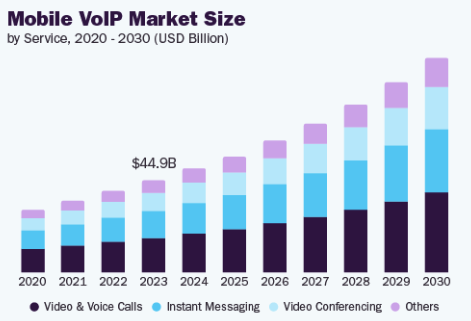Introduction
Telephonic infrastructure is fundamental to how businesses operate. From receiving and forwarding external calls to collaborating internally between team members, mobile technology has been a leading part of communications strategy for decades. Session Initiation Protocol (SIP) trunking represents a turning point in this field, bringing legacy private branch exchange (PBX) architecture into the digital age.
Due to its centrality in business operations, the telephony market generates over $500 billion in revenue each year. Despite this, its CAGR remains relatively low at around 3.6%. The VoIP CAGR, on the other hand, has paced ahead to 12.9%. This stark difference demonstrates that as businesses continue to seek innovative digital solutions, more enterprises are turning to online telephony and VoIP, while using SIP trunking to bridge the gap.

Source: Mobile VoIP Market Size 2020-2030 USD billion.
In this article, we’ll turn to SIP trunking, outlining what it is, how businesses are using it to integrate modern AI voice agent solutions, and documenting leading use cases of this new era of telephonic technologies.
What Is SIP Trunking?
Session Initiation Protocol (SIP) trunking is a strategy in telephony that enables calls to travel over the internet instead of via traditional phone lines or on-premise architecture. By transmitting voice calls over the web, SIP trunking facilitates the introduction of advanced technologies that weren’t previously available in legacy systems, like AI voice agents.
For businesses that already rely on private branch exchange telephony systems, SIP acts as a connective technology that modernizes their infrastructure. SIP trunking offers a flexible, scalable, and cost-effective method of enhancing existing systems and transforming legacy architecture.
Exploring the Benefits of SIP Trunking: Streamlining Your Digital Architecture with SIP
Here are the main benefits of SIP trunking:
- Provides a Cost-Effective Solution: Instead of having to dispose of existing architecture and invest in an entirely new telephony solution, SIP trunking utilizes existing systems, providing a solution that doesn’t rely on hardware overhauls.
- Offers Advanced Flexibility: By transforming your legacy PBX systems with SIP trunking, businesses can access total flexibility when it comes to receiving and routing calls. For example, companies can route calls to anywhere on the globe without friction, streamlining the customer and employee experience.
- Ensures High Reliability: Cloud systems and digital architecture are highly reliable solutions. With failover backups, distributed data centers, and redundant call routing, SIP trunking minimizes downtime and provides your company with unparalleled communication.
SIP transforms legacy infrastructure and future-proofs communications strategy, all while utilizing the hardware that businesses already count on.
How SIP Bridges PBX and AI
Legacy PBX systems, like those used in enterprise businesses to connect external and internal calls, are manually maintained and operated by human agents. As they are closed systems, it’s challenging to connect these traditional phone lines directly to any cloud-based AI services. SIP offers a solution, providing a streamlined method of connecting PBX on-premise systems to internet-based solutions, like AI voice agents.
By implementing a SIP bridge, your PBX will begin to send calls over a SIP URL, rather than through its original physical infrastructure. PBX systems use SIP trunking to send incoming or outgoing calls to an AI voice agent platform, like Bland.AI, which then picks up the call and serves customers in whichever way they need.
This unique combination of legacy infrastructure with cutting-edge AI voice agent technology helps revitalize your existing telephonic systems and enhance your customer care pathways.
How Can Businesses Use AI Voice Agents?
Gartner predicts that 80% of companies will use generative AI technology like voice assistants to enhance their customer services by 2025.
Here is a selection of AI voice agent use cases that your business can use to streamline customer care and enhance operations:
- Customer Scheduling: Businesses can partner with AI voice agents to streamline the process of appointment scheduling. By calling your business, a voice agent can rapidly confirm necessary details, find a time that works for you and for your customer, and oversee the entire initial contact phase. Whether you’re a healthcare provider or a sales representative, this connective solution can increase efficiency while improving customer satisfaction.
- Customer Onboarding: AI voice agents can seamlessly interact with customers to collect personal information and fill out onboarding forms, expediting the application process and enhancing customers’ initial contact stages with your business.
- Information Verification: When customers need information, your customer support channels are often their first recourse. When a customer reaches out to your company, an AI voice agent can handle their queries, automating the entire customer support process. This enhanced support pathway streamlines information retrieval and ensures consistent communication, keeping everyone on the same page.
However you serve your customers, an AI voice agent can simplify the process, automate tedious tasks, and ensure your clients can get in touch 24/7/365, in any language.
Manage Your SIP Modernization with Bland
Bland’s enterprise-grade SIP integration streamlines the digital transformation process of your legacy telephony architecture. With both inbound and outbound SIP support, full TLS and SRTP encryption, and a flexible API-based management system, your business can rapidly connect its existing services directly to Bland’s platform.
This robust integration empowers organizations to unlock the full potential of AI voice agents in a secure, scalable, and highly accessible manner. Reach out to Bland today to get started.

